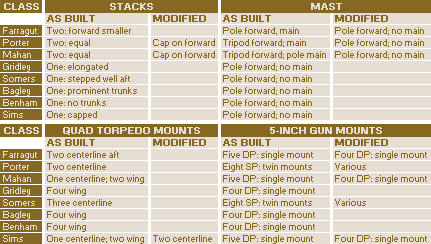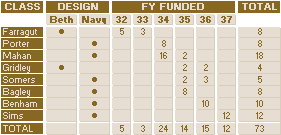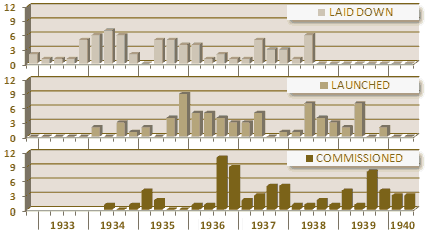

First among these were eight ships of the Farragut class, which reintroduced a raised forecastle for improved seakeeping, foreshadowed a trend toward higher-pressure boilers for longer-range steaming and, most importantly, introduced the 5-inch/38-cal. dual purpose gun which, with an effective fire control system, remained the most advanced weapon of its type through the end of World War II.
When they entered service beginning in 1934, the Farraguts represented such an advance over the flush deckers that their “over-lavish facilities” attracted criticism; old-time destroyermen soon began referring to them as “goldplaters.” Eventually, however, 73 ships (DDs 348–420—see ship list) were commissioned in five more classes—the “1,500-ton” Mahan, Gridley, Bagley, Benham classes and successor 1,570-ton Sims class plus two classes of larger “destroyer leaders,” Porter and Somers, funded in fiscal years as follows:

1932: Five original “goldplaters” (the Farraguts), with eight torpedo tubes and five 5-inch/38 cal. dual purpose guns.
1933: Three more Farraguts.
1934: Eight leaders (the Porter class) and sixteen 1,500-tonners with twelve torpedo tubes (the Mahan class) both designed by Gibbs & Cox.

1935: Two leaders of a new class (Somers and Warrington) and twelve 1,500-tonners. Originally contemplating twelve ships of an improved Mahan design, the navy instead had just two laid down (Dunlap and Fanning—the last two-stackers) while authorizing Bethlehem Steel’s Quincy, MA, shipyard to build two ships (Gridley and Craven) of a new single-stack design with sixteen torpedo tubes in four quadruple wing mounts but just four 5-inch guns; also eight of the new Bagley class from Gibbs & Cox, with machinery carried over from the Mahans.
1936: Twelve more sixteen-tube ships—two Gridleys from Bethlehem and ten more ships similar to the Bagleys but with three instead of four boilers—the Benham class—plus plus three more Somers-class leaders.
1937: Twelve slightly larger and heavier ships, the streamlined 1,570-ton Sims class, in which anticipated savings in machinery weight—needed to offset improved-but-heavier ordnance and fire control—were not achieved. Originally fitted with twelve tubes and five 5-inch/38s, these were promptly reduced to eight and four, respectively.
CONSTRUCTION
The goldplaters were laid down beginning in 1932 and, after the Farraguts arrived, were delivered in two general groups—the first concentrated in late 1936–1937 and the second peaking in late 1939 and early 1940, immediately preceding the first Bensons and Gleaves.
The 1,500-ton classes and 1,850-ton leaders were the slowest to complete, averaging 565 days from keel laying to lunch and 250 more to commissioning, a total of 815 days. The Sims class, delivered after war broke out in Europe and benefitting from an improved supply chain, were launched after an average of 448 days and commissioned after 216 more for a total of 664 days, an improvement of nearly 20 per cent. Next.